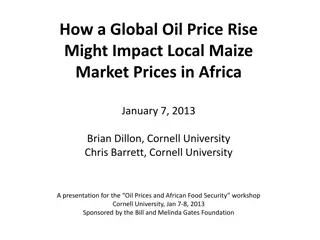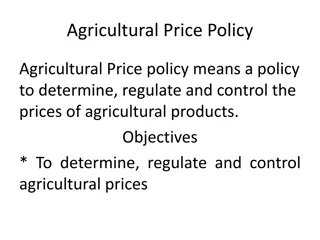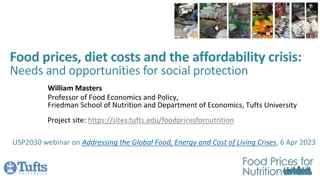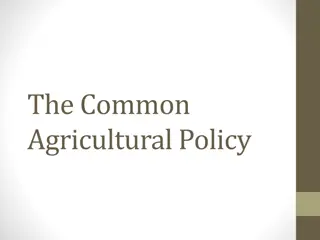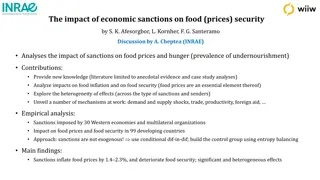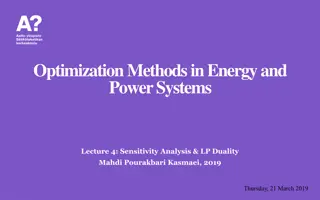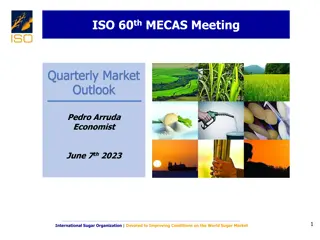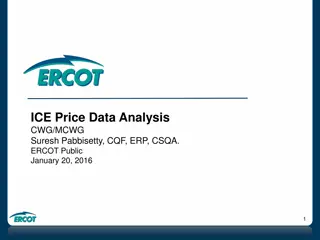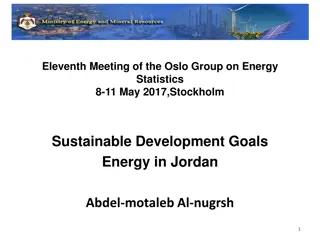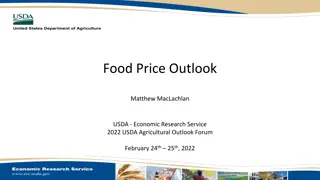Challenges and Policy Responses in Addressing Rising Food and Energy Prices
Addressing rising food and energy prices through taxation poses challenges, including ineffective targeting of support to poor households. Policy responses include cash transfers, energy price caps, and VAT reductions, with a need to balance immediate support for struggling households, fiscal consolidation post-pandemic, and climate objectives.
Download Presentation

Please find below an Image/Link to download the presentation.
The content on the website is provided AS IS for your information and personal use only. It may not be sold, licensed, or shared on other websites without obtaining consent from the author. Download presentation by click this link. If you encounter any issues during the download, it is possible that the publisher has removed the file from their server.
E N D
Presentation Transcript
Challenges in using taxation to address rising food and energy prices Alastair Thomas
Outline of presentation Policy challenges and country responses Targeting of tax concessions Who benefits from VAT and energy tax concessions? Can cash transfers better target poor households? Reform options to address rising food and energy prices Broader tax reform options 1
Policy challenges and country responses Three broad policy challenges: An immediate need to support households struggling with soaring food and energy prices. But also: A need for fiscal consolidation in many countries following the pandemic. A need to continue to address climate objectives. A range of policy responses have been implemented by countries in response to high food and energy prices, including: Cash transfers (most common approach in AEs) Energy price caps / subsidies VAT and excise tax reductions (most common approach in EMDEs) 2
VAT concessions are an ineffective way to target support to poor households Reduced VAT rates (and exemptions) may not be (fully) passed on to consumer But even with full pass-through, they will provide more support to the rich than the poor. Tax expenditure on preferential VAT rates across the consumption distribution Source: Warwick et al. (2022) 3
VAT concessions are an ineffective way to target support to poor households Average tax expenditure from reduced VAT rates in 20 OECD countries All reduced VAT rates Reduced VAT rates on food Source: OECD/KIPF (2014) 4
Cash transfers can better target support to poorer households than VAT concessions Distributional impact of removing reduced VAT rates/exemptions and using 100% of revenue to fund a universal cash transfer Source: Warwick et al. (2022) 5
Energy tax cuts (or subsidies) can be even more ineffective at targeting the poor Distributional impact of doubling fossil fuel subsidies vs a same-cost universal cash transfer (median gain across 34 low and middle income countries) Source: Dorband et al. (forthcoming), using Climate Policy Assessment Tool (CPAT) 6
Options for reform Tax concessions: May not reach consumers (incomplete/slow pass-through). Badly targeted (benefit the rich more than the poor). Difficult to remove once in place. Alternatives need to be: Better targeted. Implementable in the short term. Administratively feasible. Build off existing systems likely the most feasible approach. 7
Appropriate policy responses depend on admin capacity and existing support mechanisms Countries that have strong administrative capacity and well- developed targeted cash transfer systems (either implemented via tax or benefit system): Expand these programs to best target support to those most in need. Countries that have moderate administrative capacity and moderate targeted cash transfer systems: Expand these cash transfer programs if they effectively target those most in need. Consider implementing a universal cash transfer if a targeted cash transfer is not administratively feasible. Consider expansion of non-monetary transfers (e.g. food vouchers). 8
Appropriate policy responses depend on admin capacity and existing support mechanisms Countries that have low administrative capacity and no effective targeted cash transfer systems: Could consider applying reduced VAT or excise tax rates. But VAT reforms should: Be time limited, with the time limitation well communicated. Be focused on (basic) food items only. Excise tax reductions should: Be time limited, with the time limitation well communicated. Could be matched to fuels most used by poorest groups (e.g. particular heating fuels). Consider temporary energy price caps / subsidies. Consider expansion of non-monetary transfers (e.g. food vouchers). 9
A broader package of reforms to increase revenue and achieve equity goals Countries could look to implement more comprehensive reform that both raises revenue and achieves equity and environmental goals. This could include: Enhancing targeted cash transfers to support poor households. Increasing the progressivity of the PIT, including through taxing capital income and gains. Broadening tax bases, including CIT and VAT, by removing ineffective/inefficient tax concessions. More effective taxation of property and wealth. Increasing tax administration capacity. Reducing fossil fuel subsidies / increasing energy taxes to effectively price carbon emissions. Taxation of windfall gains see next presentation! 10
Thank you athomas@worldbank.org 11


